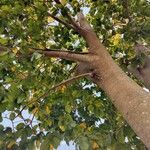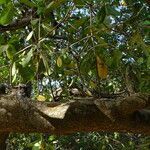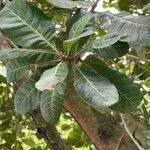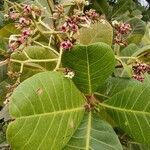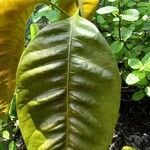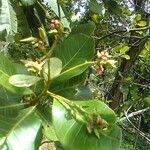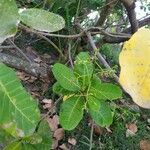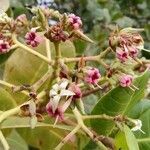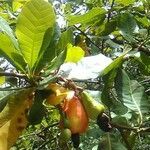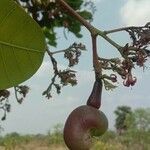Tree to 8(-10) m. Leaves ? aggregated toward the apex of the branchlets, the petioles 5-20 mm long; blades broadly oblong-ovate to somewhat obovate, obtuse to rounded or slightly emarginate at the apex, cuneate to obtuse or rounded at the base, glabrous, 6-15.5 cm long, 3.5-9 cm broad, with prominulous reticulation on both surfaces. Panicles 7-16.5 cm long, with gray pubescence; bracts usually at least sparsely puberulent,-those subtending the lower primary branches of the panicle oblanceolate or oblong and foliaceous (though much reduced in size), those subtending the distal branches and flowers or flower-groups ovate and resembling the calyx-lobes. Flowers with pedicels 0.5-7 mm long; calyx-segments lanceolate to lance-ovate, 2.5-5 mm long, 1-2.3 mm broad, moderately grayish-appressed-puberulent dorsally; petals linear to linear-lanceolate or narrowly linear-elliptic, 6-13 mm long, 1-2 mm broad, greenish-yellow with red streaks at anthesis, turning dark red with age; stamens 10, 1 much longer than the others and extending well beyond the point at which the petals become recurved, the filaments glabrous; ovary 0.2-0.5 mm long. Hypocarp red or yellow at maturity, to 10 cm long and 5 cm broad, ? obovate. Nut gray, 2-3.2 cm long, 1-2 cm broad.
Tree up to 12 m high and 40 cm ø, trunk usually crooked. Bark brown, rather smooth. Leaves coriaceous, obovate, sometimes broadly elliptic, 4-22½ by 2½-15 cm, glabrous; base cuneate, or obtuse; apex rounded, sometimes slightly emargi-nate; nerves 8-20 pairs, veins reticulate; petiole ½-2cm. Panicles or sometimes corymbs up to 26 cm long, pubescent, glabrescent; floral bracts ovate-oblong, 5-10 mm long; pedicels 2-5 mm. Flowers fragrant, unisexual (5) and bisexual ones on the same plant. Calyx lobes unequal, ovate-lanceolate, 3-5 mm long. Petals linear, 7-15 mm long, reflexed at anthesis, at first pale greenish-cream with red stripes, soon turning red. Stamens 2-12 mm; anthers ⅔-1 mm long. Disk none. Ovary c. 1 mm Ø; style 4-12 mm; rudimentary pistil in ♂ 2-3 mm. Drupe reniform, 2 ½-3½ by 1½-2 cm, greyish brown when fresh; hypocarp fleshy, pyriform, 2-3 by 1-2 cm (in fresh state 3-4 times the length of the fruit, shiny, red or yellow, 10-20 by 4-8 cm). Seed reniform, 1½-2 by 1 cm.
Trees or shrubs, 4-10 m tall; branchlets glabrous to subglabrous. Petiole 1-1.5 cm; leaf blade obovate, 8-11 × 6-8.5 cm, leathery, glabrous on both sides, base broadly cuneate, margin entire, apex rounded, truncate to retuse, lateral veins ca. 12 pairs, reticulate venation pattern prominent on both sides. Inflorescence paniculate, 10-20 cm, glabrous to densely grayish sericeous; floral subtending bracts ovate-lanceolate, 5-10 mm, keeled, grayish sericeous abaxially, glabrous adaxially. Flower sessile to shortly pedicellate. Calyx grayish sericeous abaxially, ca. 4 × 1.5 mm. Petals 5, greenish yellow to red, linear-lanceolate, 7-9 × ca. 1.2 mm, grayish sericeous abaxially, minutely pubescent to subglabrous adaxially. Stamens 7-10, larger one 8-9 mm in male flowers, 5-6 mm in bisexual flowers, sterile stamens 3-4 mm. Ovary ca. 2 mm, glabrous; style 4-5 mm. Fleshy hypocarp 3-7 × 4-5 cm, purplish red at maturity; drupe reniform, 2-2.5 × ca. 1.5 cm. Fl. Mar-Apr, fr. Jul-Aug.
A spreading evergreen tree up to 7-14 m tall. It has spreading branches. The canopy can spread 12 m. The roots grow deeply and spread widely. The bark is rough. The trunk is 15-20 cm across. The leaves are alternate. The leaves are pale green and large. They are 10-15 cm long by 6-8 cm wide. They have fine veins. They are narrow at the base. The leaf stalk is 1-2 cm long. The leaves are shiny. The flowers are produced on the ends of the branches. They are red in colour. About 14 % of the flowers are both male and female and the remainder are male. Many of the flowers which contain female flower parts do not form fruit. The nut is borne below the "apple" which is really a fleshy stalk. The nut is kidney shaped. It is about 3 cm long.
Leaves glabrous; petiole 1–3 cm. long and c. 2 mm. broad at the base, hemicylindric; lamina slightly discolorous, shining, 6·5–18 × 3·8–10 cm., broadly obovate to oblong-obovate, obtuse, rounded or emarginate at the apex, cuneate or rounded at the base, coriaceous to subcoriaceous; midrib not raised above, very prominent below, lateral nerves 9–17 pairs, slightly raised, reticulation slightly visible.
Inflorescence 10–25 cm. long, with reddish to blackish ascendent puberulous branches; pedicels c. 0·5 mm. long, puberulous; bracts 5–10 × 2–5 mm., ovate-lanceolate, densely greyish-puberulous outside, glabrous inside.
Fruit greenish-yellow, 2–3 × 1·5–2·5 × 1·5 cm., laterally umbilicate, with a very thickened and fleshy pedicel, 6–7·5 × 4·5 cm.
Stamens unequal, 1–2 with filaments 6–9 mm. long, the others with filaments 2–3 mm. long and sterile anthers.
Petals yellowish-white to pale reddish, 7–13 × 1–1·7 mm., linear-lanceolate, puberulous on both faces.
Calyx segments 4–5 × 1–2·2 mm., lanceolate to oblong-ovate, greyish-puberulous outside.
Ovary of the hermaphrodite flowers obliquely obovoid, puberulous; style c. 4 mm. long.
A shrub or tree up to 10 m. tall, with rather thick glabrous striate branchlets.
Pending.
